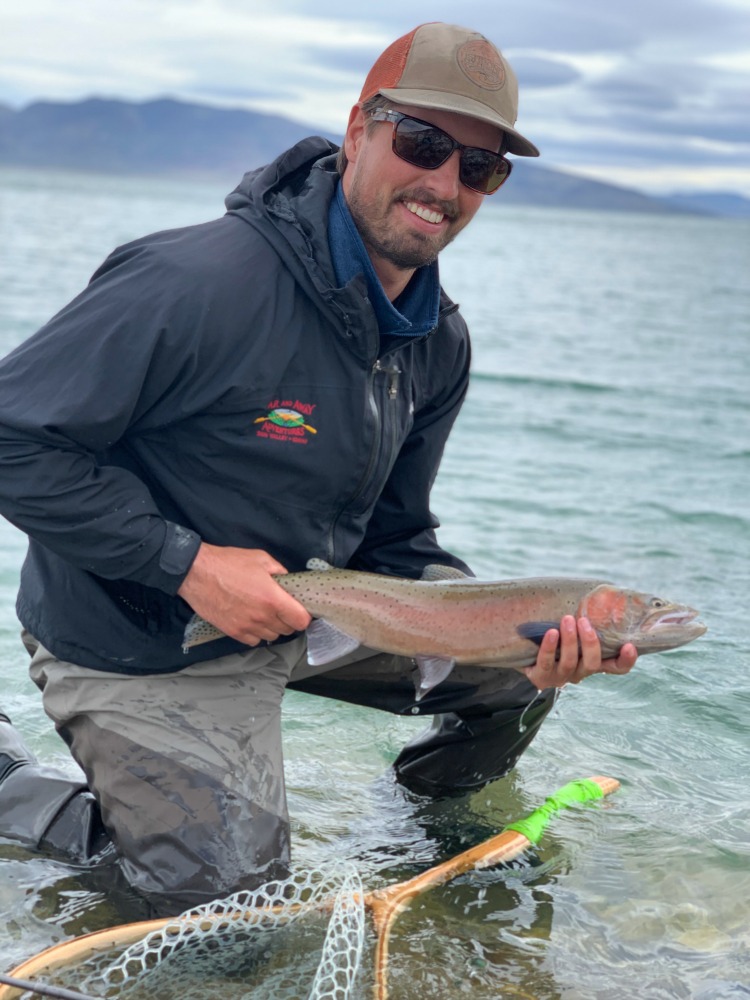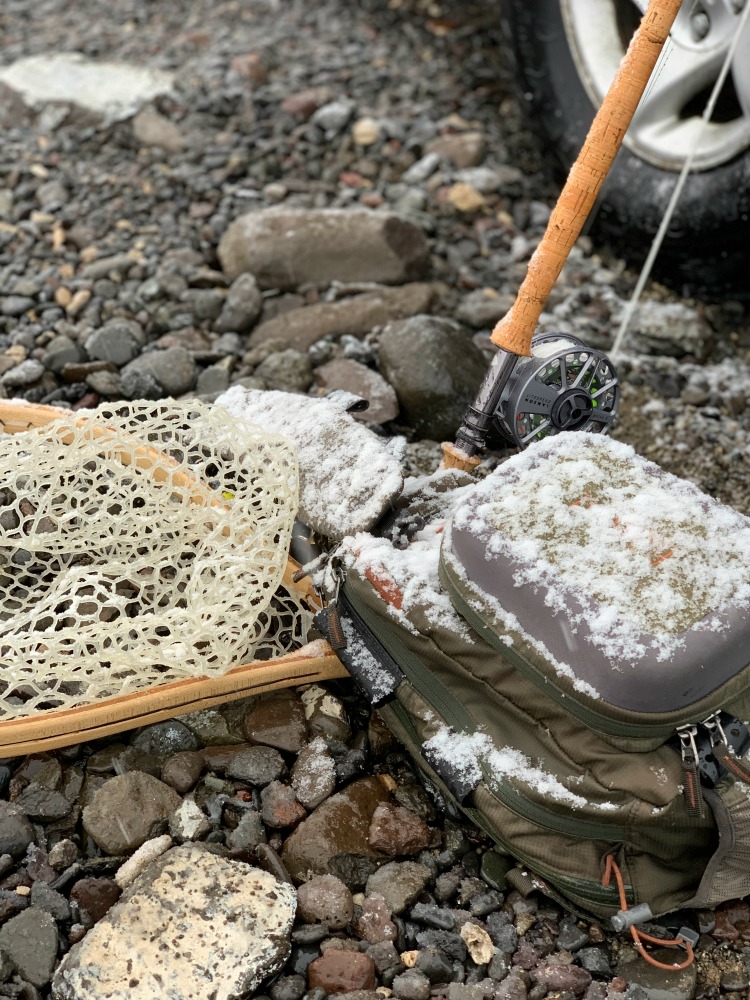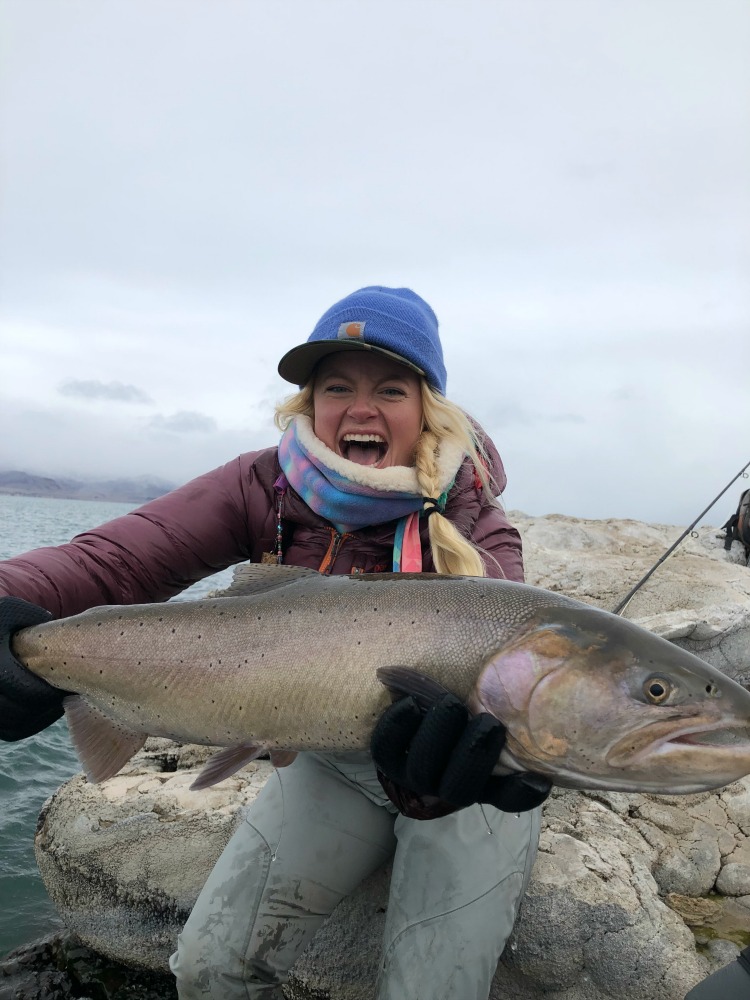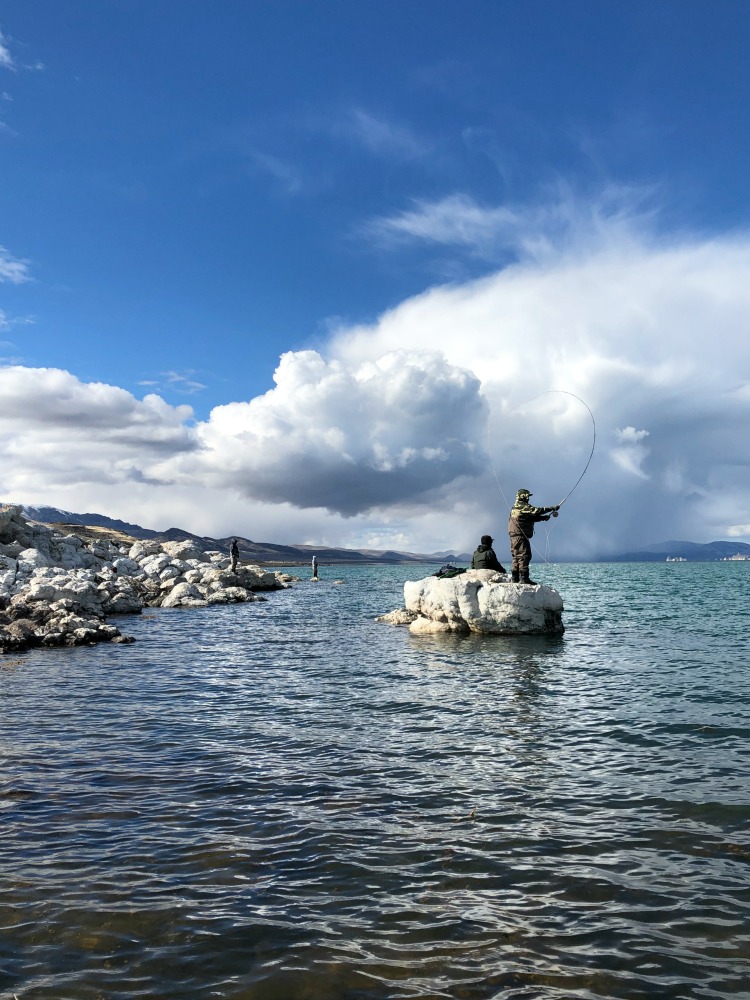A Jurassic Park-style comeback turns a quiet corner of Nevada into a world-class fishing destination
I can no longer feel the line slipping past my numb fingertips as I pull it through the choppy black water of Pyramid Lake, Nevada. The weather is cold and miserable, but it makes for golden hour fishing out here in the desert — or so I’m told. Ice builds around the guides on my fly rod. I flick it away and roll out another cast, watching as my indicator rises and falls like a ship caught in a Cape Horn storm. About eight feet below the bobber a small artificial fly called a “chironomid” sits waiting. It’s really nothing more than a skinny wrap of amber thread and wire around a hook barely longer than one of my mustache whiskers. Standing in the cold staring at a tiny red dot hop up and down among the waves, this whole enterprise seems futile, but about a decade of trial and error by some very determined fishermen has proven it’s one of the best ways to catch Lahontan Lake Trout. The prehistoric goliaths that recently swam out of extinction and into Pyramid Lake.
I’m not alone in this quixotic fishing venture. Joining me on a soggy boulder is my partner Amory (in life and in fishing) bundled so extensively that all I can see are her frosty eyelashes. Most of the southwest bank of the lake, a more than ten mile stretch surrounding us, is lined with fishermen numbering in the hundreds. Some are on the bank, some are fishing from step ladders dragged out into water near deeper shelves — a style of fishing unique to Pyramid. Amory and I made the short one hour drive from Truckee, California to be here, but many have made a far longer journey. They’ve come from Idaho, Utah, Southern California, New York, and around the globe to stand in the freezing rain waiting for their bobber to drop.
Why? Most would say to catch trophy size trout, which is true, but I believe it’s more than that. They’ve come for the story and because they want to become a part of that story.
Pyramid Lake is all that’s left of a watery mass that once covered most of Northern Nevada until the end of the last ice age. The giant endorheic lake was called Lake Lahontan. While its banks were once patrolled by mammoths, giant sloths, ancient horses, and even camels, its waters were home to the giant Lahontan cutthroat trout, Oncorhynchus Clarkii Henshawi. These prehistoric fish survived the gradual evaporation of Lake Lahontan, confined eventually to Pyramid Lake where they became a primary food source for the Paiute Tribe, whose reservation encompasses the entire lake. The mighty Lahontans’ multi-millennia-long run ended in 1943, however, when overfishing by incoming settlers and the poorly designed Derby Dam dropped the lake level by 90 feet and closed off the spawning route, which quickly led to their extinction.
According to Pyramid Lake Fishery Director and Paiute tribal member Albert John, the tribe lost its fish and its water simultaneously.
“How big the fish were,” John reminisces, echoing the stories he’s heard passed down through the generations. “They’d just talk about how they went up there and there were huge guys growing up there about four feet long. It’d be something to see, if you could go back in time it would be awesome.”
Standing on the tufa boulder, we can see the pre-derby dam high water mark high above us. Looking out over the 300 square mile lake, it’s difficult to imagine the quantity of water that was lost to the tribe 80 years ago.
Stocking efforts eventually tried to introduce other species to the lake. Foreign varieties of cutthroat trout from the Walker River to the south or even some strains from Idaho, but due to the high alkaline content of the lake nothing stuck until the 1970s, when the Summits arrived. As Lake Lahontan dried up 10,000 years ago, it stranded cutthroat in numerous other lakes besides Pyramid. Independence Lake, California was one such place, and Summit Lake Nevada was another. In the 1970s the tribe and its partners began stocking the lake with cutthroat trout from the latter (called Summits) and for the first time since the 1940s Pyramid had cutthroat again. It was an incredible development, but with two major caveats. The Summits were much smaller in size than Pyramid’s original inhabitants, and needed to be continually supported by a hatchery because they wouldn’t spawn and reproduce on their own.

This is how the lake appeared in 1989, when John was new on the Paiute Tribal Council and first started focusing on the tribe’s issues with water and its fishery. At that time there was an element of hope on the horizon, for the fish at least. Fourteen years earlier a biologist named Don Duff was searching for Bonneville cutthroat trout — another of the 14 subspecies of cutthroat — in the Pilot Peak mountain range along the Nevada/Utah border. He’d heard about two perennial streams in the range from local ranchers, and was using a fly rod to catch specimens since he couldn’t acquire a collection permit at the time. As he jigged a small fly along the bottom of one of the streams he felt a small tug at the end of his line, becaming the first person to catch a subspecies of cutthroat thought to have gone extinct hundreds of miles away more than 30 years before.
When Duff pulled in the peculiar, snaky looking cutty he had no idea of its link to Pyramid Lake. He sent the samples to a colleague named Dr. Robert Benke at Colorado State University. After seeing the samples, Benke hypothesized they could be related to the bygone trout from Pyramid Lake. When the samples were genetically tested decades later it turns out he was right on the money. In 2002, a conservation geneticist from the University of Nevada-Reno named Mary Peacock, found an identical genetic match between Duff’s fish and DNA from samples of Lahontan Lake trout at the Smithsonian Institute — the trout had officially come out of extinction.
But how did it end up hundreds of miles away from Pyramid Lake? Duff is among most who guess it was a case of extreme luck, courtesy of the transcontinental railroad. Misguided stocking efforts were common in the early part of the 20th century and they almost always failed — except in the case of whoever hopped off the train near Pilot Peak pre-1943 and dumped in a carton full of Lahontan fish eggs, Duff muses.
After his discovery, Duff personally kickstarted an effort in a couple private ponds to preserve the trout strain. The Lahontan Fish Hatchery, a U.S. Department of Fish and Wildlife run complex devoted to cultivating populations for the Lahontan and endangered cui cui fish, would come out every year to pick up some eggs until it had a robust enough supply of eggs and trout that it ended the partnership. In spite of the split, Duff continues to look after the original ponds with the help of Trout Unlimited and the Utah Division of Wildlife.
“I kept involved over the years because I didn’t want to see them go extinct again,” explains Duff, “and I intend to protect those fish until I go to my grave.”
The storm has really picked up force now as waves crash against the rock we’re on, sending spray in every direction and making it difficult to tell if the water is coming from above or below. Because the bank rises quickly behind us we are using a technique called a roll cast to chuck the fly and indicator as far as we can without casting behind us and risking a snag. In a swift but smooth motion I sweep the tip of my rod back across the water, up to the sky, and out again. The friction of the water against the line bends the rod until it releases forward and shoots out into the waves. I continue to wait, watching my bobber and thinking about the fish I hope to catch.
While Duff may have found the Lahontan trout in the 1970’s, reintroduction didn’t begin immediately, in fact it took 40 years. John explained how the tribe began looking into the Pilot Peak strain in the 1990’s, but it wasn’t until 2006 that the council finally decided to reintroduce them to Pyramid Lake. The catalyst for this decision was a visit to one of Duff’s ponds near Utah. Where tribal members first laid eyes on a 10 pound rebirth of the trout their ancestors once fished.

It’s now been 13 years since the first finger sized Pilot Peak hatchery trout were dumped into Pyramid, and they’ve taken to it like they’ve lived there for millennia. The most pivotal moment in their reintroduction came in 2014, when for the first time in 80 years, the Lahontans began to spawn again.
The historic size of the fish is returning as well, and the limit is a guessing game. The first 20 pounder was recorded in 2012, and the modern record is just over 30 pounds. According to John and just about any guide you ask from the many companies like Pyramid Fly Co. or Pyramid Lake Fly Fishing that now offer guided fishing trips to the lake, everyone is still waiting to see if the Pilots regain their legendary size.
“The Pilots don’t mature until they’re 16 [years old], so they could get a little bit bigger but we’re not sure,” John said.
Back on that cold boulder looking out over a surreal desert moonscape and stormy black waters and snow dusted hills behind us, those Lahontan monsters may as well have still been extinct. As often happens to those fisher folk who have not caught anything in far too long, Amory and I make attempts to pretend we’re not getting moody. I crack a joke; comment on the natural beauty of the space. Amory pretends to laugh and gives an affirming and resounding, “yeah.” But just when the weather has almost frayed our nerves to the breaking point, Amory’s indicator drops.

She whips her rod tip to attention, and spends the next ten or fifteen minutes practicing a form of icy-rock ballet meets tug-of-war until she is holding a thrashing flash of autumn red and chrome by the tail. It’s a twelve pound Pilot Peak cutthroat, aka Lahontan Lake Trout, back from the abyss of extinction and into her smiling arms for a few fleeting moments before we send it back home into the cold dark water.
Me? I got skunked that day – a fact that Amory will likely never let me live down. But that’s what keeps me coming back to Pyramid Lake: the promise of a maybe. It’s the chance to be a part of a Jurassic comeback story — to see the Lazarus of Pyramid Lake, the fishy phoenix of Nevada — and thanks to Duff, John, and many others, for the first time in a long time these big beautiful trout are finally back where they belong and aren’t going anywhere.
Lake Monsters Across the West (and beyond)
Fly fishing hits its stride on clear western rivers, but you can’t match lake fishing pound for pound. From the Lahontans of Pyramid Lake, to the mackinaw of Tahoe, and the Mccloud rainbows of Jurassic Lake in Argentina, here are some of the best spots to beat your personal record and catch the trophy trout of your dreams. Remember that lake trout stay low in the peak summer, so fall and spring are the best times to plan a trip.
Lake Tahoe and Donner — California/Nevada
Lake Tahoe and nearby Donner Lake are the perfect destinations to tie some mountain living into your Sierra Nevada fishing trip, and throw in some breathtaking scenery to boot. Big Blue is only an hour and a half drive east of Pyramid Lake, and Mackinaw near 40 pounds and brown trout over 15 pounds have been pulled out of its waters. Donner Lake is a short 20 minute drive from Tahoe and can be a great way to escape the crowds, a perfect stop if you want to take out your own boat.
Flaming Gorge Reservoir — Utah/Wyoming
A quick google search will show why Flaming Gorge is an imperative stop for lake fishing in the Rockies — headlines about fishermen smashing state records and countless grip-and-grin photos of behemoth trout instantly light up the screen. Like most lakes you’ve got a better chance to limit out trolling from a boat, but stripping a streamer with a fly rod over the reservoir’s many drop offs can also deliver great results.
Yellowstone Lake — Wyoming
If you’re looking for huge trout to toss on the grill, head to Yellowstone Lake and eat your heart out. The lake trout here were illegally introduced and have actually decimated the native cutthroat trout population, and the National Park Service launched an extensive effort to quell the lake trouts’ numbers. If you hook into one here, it’s actually illegal to release it back into the water. Time to fire up the smoker.
(Bonus) Jurassic Lake — Argentina
OK, this isn’t technically in the American West, but any mention of Pyramid Lake deserves a shout out to Lake Strobel in Argentina, known to most fishermen simply as “Jurassic Lake.” In the lake fishing scene, spinning rods typically outmatch all else, but Pyramid and Strobel are arguably the two best places in the world to fish for gigantic trout with a fly rod. The lake was barren until about 20 years ago when a strain of Mccloud rainbow trout from the Mccloud River in California were introduced in a stream that flowed into the lake. Strobel’s enormous population of freshwater shrimp provided an endless buffet for the trout that began a spawning run from the lake, back up the Rio Barrancoso, and the trout have since grown to be some of the largest Rainbows in the world. Some reach sizes of 40 pounds, far outgrowing their original size back in California. I once fished the Mccloud River itself and the largest rainbow I caught was about 12 inches.




